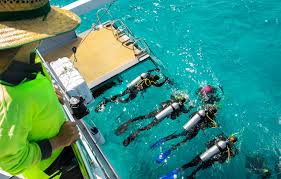What Does SCUBA Stand For? Plus Other Diving Acronyms You Should Know
SCUBA, an acronym that has transcended its technical origins to become a universally recognized term, stands for “Self-Contained Underwater Breathing Apparatus.”
SCUBA stands for “Self-Contained Underwater Breathing Apparatus,” a term coined by Dr. Christian Lambertsen in 1954 for his innovative diving equipment. This acronym, along with others like PADI and MOD, forms the essential language of diving, ensuring safety and efficiency for underwater explorers.
Coined by Dr. Christian Lambertsen in 1954, SCUBA originally described his innovative breathing apparatus, which allowed divers to explore underwater environments independently from surface air supplies. This invention was revolutionary for both military and recreational diving, paving the way for the diving techniques and equipment we use today.
A Brief History of SCUBA Diving
While Dr. Lambertsen is credited with creating the term SCUBA, the concept of underwater exploration predates him by centuries. Early diving methods included the use of hollow reeds as makeshift snorkels and the use of inflated animal bladders to store air.
By the 16th and 17th centuries, diving bells were commonly used for underwater exploration and work, allowing divers to stay submerged for extended periods.
One of the most significant developments in diving technology was the invention of the Standard Diving Dress (SDD), which included a copper helmet and suit. Though restrictive by modern standards, this equipment provided a level of freedom previously unattainable for divers.
The Evolution of SCUBA Technology

SCUBA technology has evolved significantly since its inception. There are two main types of SCUBA systems: closed-circuit and open-circuit.
Closed-Circuit SCUBA: This system, also known as a rebreather, recycles exhaled gases by filtering out carbon dioxide and reusing unused oxygen. The closed-circuit system is particularly advantageous for military divers, as it produces no bubbles, making it ideal for stealth missions.
Open-Circuit SCUBA: The open-circuit system, more commonly used by recreational divers, allows exhaled gases to be released directly into the water. This system became popular due to the invention of the demand regulator, which conserves air by providing it only when the diver inhales.
Breaking Down the SCUBA Acronym
- Self-Contained: The equipment allows the diver to operate independently from surface air supplies, enabling greater freedom of movement underwater.
- Underwater: Refers to the environment in which the SCUBA gear is used, allowing humans to explore subaquatic realms.
- Breathing: The apparatus provides breathable air, enabling the diver to survive under pressure in deep waters.
- Apparatus: Encompasses all the gear necessary for underwater respiration, including the mask, regulator, tanks, and valves.
Essential Diving Acronyms
Beyond SCUBA, the diving world is filled with acronyms that help divers communicate efficiently and remember important protocols. Here are some key acronyms every diver should know:
- PADI (Professional Association of Diving Instructors): The world’s leading scuba diving training organization, offering courses from beginner to professional levels.
- SSI (Scuba Schools International): Another major diving certification agency, known for its flexible and practical approach to dive training.
- MOD (Maximum Operating Depth): The maximum depth at which a particular gas mixture can be safely breathed without risking oxygen toxicity.
- RNT (Residual Nitrogen Time): Refers to the amount of nitrogen remaining in a diver’s body after a dive, which must be considered when planning subsequent dives.
- BWRAF (Buoyancy, Weights, Releases, Air, Final Check): A pre-dive safety check acronym that ensures all equipment is functioning correctly before a dive.
The Importance of Diving Acronyms

Diving acronyms are not just convenient shorthand; they play a crucial role in ensuring diver safety. Whether you’re planning a dive, conducting pre-dive checks, or managing an emergency, these acronyms provide a systematic approach to remember essential steps and protocols.
For instance, the BASE acronym (Buoyancy, Awareness, Streamlining, Equipment) emphasizes the importance of maintaining proper buoyancy, staying aware of your surroundings, and ensuring your equipment is in good working order.
Similarly, CESA (Controlled Emergency Swimming Ascent) is a critical emergency procedure that all divers must be familiar with, as it can be a lifesaver in situations where a diver runs out of air.
Conclusion
The acronym SCUBA may stand for “Self-Contained Underwater Breathing Apparatus,” but its impact on diving goes far beyond these words. It represents a gateway to underwater exploration, enabling divers to discover the hidden wonders of the ocean. Alongside other diving acronyms, SCUBA forms the language of the diving community, helping ensure safety and efficiency in an environment that demands the utmost respect and caution. Whether you’re a novice diver or a seasoned pro, understanding these acronyms is essential for a safe and enjoyable diving experience.




